Journal of Oceanography | Lupine Publishers
Abstract
Aromatic hydrocarbons (toluene and xylene) are highly water soluble
and their contamination with groundwater is a serious
issue. Hydrocarbons are growth substrates for microorganisms which use
them as a sole source of carbon and energy. Surfactants
increase the solubility and dissolution of hydrocarbons thus making them
susceptible to degradation. In this study, biodegradation
of toluene and xylene using a soil bacterium was evaluated in the
presence of chemical surfactant. The colonies that were tested
positive for xylene and toluene degradation in the primary screening
were analyzed by 16s rRNA sequencing and identified as
Bacillus Cereus. The presence of chemical surfactant enhanced the
growth of bacterial isolate and its bioremediation activity
indicated the possible role of the tween in bioremediation process. It
was observed that pH of the medium has reached near neutral
from initial pH of 8.2 at the end of 21 days cultivation period.
Addition of hydrocarbons in the mineral salt medium (MSM) has
enhanced the bacterial growth as confirmed by increasing optical density
throughout the cultivation period. Increase in protein
content of bacterial isolate indicated its metabolic activity in the
presence of hydrocarbons. Similarly, increase in the rhamnolipid
concentration of B. cereus grown in MSM along with hydrocarbons and chemical surfactant indicated the role of rhamnolipids
during the biodegradation of xylene and toluene.
Keywords: Aromatic Hydrocarbons; Rhamnolipid; Surfactant; Xylene; Toluene; Bacillus Cereus; Bioremediation
Aromatic hydrocarbons are molecules containing one or
more aromatic rings in their structure and are the most prevalent
pollutants in the environment. These compounds are widely used
as fuels and industrial solvents and they enter the environment
through oil spillage, fossil fuel combustion and natural petroleum
seepage. Bioaccumulation of aromatic hydrocarbons in food chains
makes them as potential human health hazards. Biodegradation
is the removal and transformation of contaminants using living
organisms into harmless substances. Microorganisms can degrade
environmental pollutants by transforming them into harmless
metabolites [1]. It is noteworthy to mention that aromatic
compounds are growth substrates for microorganisms which use
them as a sole source of carbon and energy. The breakdown of
aromatic hydrocarbons by ring cleavage through microbial activity
is an important step in carbon cycle, [2] and the degradation
involving microorganisms may be aerobic or anaerobic process.
Aerobic degradation involves oxidation of alkyl side chain of the
aromatic ring to produce carboxylic acids [3], whereas anaerobic
process involves enzymatic degradation [4]. Toluene is an aromatic
hydrocarbon and causes various health hazards [5-7]. Xylene is
mainly used as solvent in industries and medical technologies.
Xylene can enter into soil and water bodies where it remains for
months before transforming into other chemicals. Inhalation of
xylene vapor causes depression of the nervous system [8]. Both
toluene and xylene are highly water soluble and their contamination
with groundwater is a serious issue. Surfactants increase the
solubility and dissolution of hydrocarbons thus making them
susceptible to degradation. Majority of the surfactants are derived
from petroleum products which further causes environmental
problems. Biosurfactants produced by microorganisms are
alternate to synthetic surfactants as they are not only eco-friendly
but also functions well at extreme conditions. Rhamnolipids are a
class of biosurfactants consisting of one or two rhamnose molecules
with a glycosidic linkage [9,10]. When hydrocarbons are used as
carbon source, some microorganisms produce rhamnolipids to
utilize them [11,12]. In this study, biodegradation of hydrocarbons
(toluene and xylene) using a soil bacterium was evaluated in the
presence of chemical surfactant. Rhamnolipid synthesis by the
bacteria during the degradation process was also evaluated.
Isolation of Aromatic Hydrocarbon Degrading Bacteria
The soil which was contaminated with crude oil and petroleum
hydrocarbons for over 6 months was selected as the source to isolate
the aromatic hydrocarbon degrading bacteria. About 0.1gm of soil
sample was suspended in 0.9ml of distilled water and subjected to
serial dilution. The tubes 10-9 and 10-10 were then plated onto the
mineral salt medium (MSM). The plates were sprayed with toluene
(10%) and xylene (10%) and incubated at 25°C for 5-10 days.
The organisms that formed clear zones around the colonies were
considered as hydrocarbon degraders. The isolates were further
screened by overlay technique [13]. 0.1ml of sample aliquots was
added to the plates and the inoculum was spread over the agar
surface. The plates were then incubated at 37°C for 48 hours and
the grown predominant colonies were selected for further studies.
Identification of Aromatic Hydrocarbon Degrading Strains
The isolates obtained were then screened for bioremediation
of aromatic hydrocarbons (xylene and toluene) using mineral salt
medium (MSM) (1.8g K2HPO4, 4.0 g NH4CI, 0.2g MgSO4.7H2O, 0.1g
NaCl, 0.01g FeSO4.7H2O in 1 L distilled water) in the presence and
absence of surfactant (Tween 40). About 10 ml of the inoculum
was added to 250 ml conical flask containing 100 ml of mineral salt
liquid medium.
Flask 1 : MSM + Inoculum (control)
Flask 2 : MSM + Inoculum + AH
Flask 3 : MSM + Inoculum + AH + Tween
Flask 4 : MSM + Inoculum + Tween
Flask 5 : MSM + AH (negative control)
The experiments were done in triplicates and the flasks were
incubated at 37°C for 21 days. The samples were analyzed at regular
intervals (7th day, 14th day and 21st day) for pH of the medium,
growth curve, total proteins and rhamnolipid production.
Total protein of the cultures was estimated by following
Lowry’s method. Briefly, 1ml of the culture was taken from each
sample and centrifuged at 10,000rpm for 20 min. The pellet
obtained was washed with Ringer’s solution and the pellets were
resuspended in 4.6 M NaOH to boiling temperature for 10 mins.
Total protein estimation was estimated by Lowry’s method using
BSA as standard.
Rhamnolipid from the bacterial culture was extracted by
centrifuging the culture (10,000 g) and extracting the supernatant
with 1 ml of chloroform and ethanol (2:1 v/v). The organic phase
was evaporated to dryness and the precipitated was dissolved in 0.5
ml of water. The quantification of rhamnolipids was done by adding
0.9 mL of 0.19% orcinol (in 53% H2SO4) to 0.1 ml of sample. The
solution mixture was heated for 30 min at 80°C and the samples
were cooled at room temperature. The absorbance was measured
at 421 nm in a UV-Vis spectrophotometer and the rhamnolipid
concentration was calculated from standard curves prepared with
L-rhamnose (0-50 mg/L) and expressed as rhamnose equivalent
[14].
16s rRNA Sequencing
The colonies isolated and tested positive for the
hydrocarbon degrading assay were purified for identification.
DNA from the isolates was extracted from the colonies
and 16s rRNA sequencing was carried out using universal
primers 27F (5’-AGAGTTTGATCCTGGCTCAG-3’) and 1392R
(5’-GGTTACCTTGTTACGACTT-3’) (Eurofins, Bangalore).
Results
The predominant colonies appeared during initial screening
was labeled as X2 (xylene degrader) and T1 (toluene degrader)
and subjected to hydrocarbon degradation assay. The assay was
carried out in four different flasks having various combinations as
mentioned earlier. Both the medium and inoculum were withdrawn
at 7th, 14th and 21st day of incubation and analyzed for degradation
assays.
pH of the Medium
Medium from the inoculated flasks was collected at regular
intervals to determine the pH as a function of bioremediation
process. In all the flasks, pH was reduced with increased incubation
period and the pH of the flask that has mineral salt medium
(MSM)+inoculum+xylene+tween had a pH of 8.2, 7.89 and 7.12
at 7th, 14th and 21st days of incubation respectively. In the case of
toluene degradation, flask with MSM+inoculum+toluene had a pH
of 8.35 at 7th day and was reduced to a pH of 7.11 at the end of
incubation period. pH of the other flasks during the cultivation
period is represented in Figure 1a & 1b
Bacterial Growth Curve
Bacterial growth in the inoculated flasks was determined at
regular intervals through colorimetric estimation using the flask
containing mineral salt medium and inoculum as blank at 620 nm.
The optical density values were increased with incubation period
indicating the growth of bacteria in the medium. Highest OD value
was observed in flask containing MSM+inoculum+xylene+tween which was followed by MSM+inoculum+xylene. For toluene
degradation, flask containing MSM+inoculum+toluene recorded
the highest OD value (Figure 2a & 2b).
Total Protein Estimation
The total protein content of aromatic hydrocarbon degrading
bacteria grown under various combinations was calculated using
BSA as standard (R2=0.993). Total protein concentration of strain X2
from the flask containing MSM+X2+xylene+tween was in the range
of 0.105-0.189 μg ml-1. In the flask containing MSM+T1+toluene,
highest protein content was recorded (0.307 μg ml-1) at the end of
cultvation period (Figure 3a & 3b).
Rhamnolipids Synthesis
Synthesis of rhamnolipids by the bacterial isolate grown in the
presence of aromatic hydrocarbon was quantified by colorimetric
method. The presence of synthetic surfactant (tween 40) in the
growth medium had increased the production of rhamnolipids in
both xylene and toluene containing media. The concentration of
rhamnolipid in xylene degrading bacteria was in the range of 0.14-
0.23mg l-1 and the production was three-fold increased with the
addition of tween (Figure 4a & 4b). However, there was a 42.8%
increase in the rhamnolipid synthesis by the toluene degrading
bacteria at the end of 21 days incubation period in the flask
containing MSM+inoculum+toluene+tween (0.34mg l-1) than flask
without tween (0.238mg l-1).
16s rRNA Sequencing
The colonies that were tested positive for xylene and toluene
degradation were identified by 16s rRNA sequencing. The sequence
obtained was then checked for sequence similarity among the
organisms for identity. The sequence was then compared using
Blastn and the query was found to have 99% identity with Bacillus
cereus (Figure 5a & 5b).
Figure 5b: Neighbor-joining method cladogram showing phylogenetic relationship between strains (strains X1 and T2) and
other related reference microorganisms based on the 16S rRNA gene sequence analysis.
Soils contaminated with aromatic hydrocarbons are a major
threat to the soil ecosphere. The low bioavailability of polycyclic
hydrocarbons to microorganisms makes them difficult to undergo
bioremediation [15]. There are several microbes which are found
useful in biodegrading such contaminants. Bacterial consortium
involving Bacillus subtilis and Pseudomonas aeruginosa was
reported to degrade aromatic hydrocarbons effectively [16]. In this
study, bacterial isolates from the soil samples were screened for the
bioremediation activity, and only two isolates were found to degrade
the tested aromatic hydrocarbons. On the basis of morphological
features and 16S rRNA analysis both strains were assigned to
Bacillus Cereus. In order to find the efficacy of degradation,
flasks
with different combinations of hydrocarbons were used. Tween
40 was used as surfactant to solubilize the hydrocarbons and four
different flasks were used separately for both xylene and toluene
degradation assay. The presence of chemical surfactant enhanced
the growth of bacteria and its bioremediation activity indicating
the possible role of the tween in bioremediation process. For
bioremediation, the optimal pH is between 6.5 and 8.5. Most of the
microbial processes are associated with the addition of electron
donors and as such tends to decrease the pH. The pH of all the
experimental samples were maintained at about pH 6.04- pH 8.2,
which was the optimum for bioremediation. The pH of all samples
was found to be gradually decreased from 7th day to 21st day. The
reduction in pH levels in the experiment in agreement with [17]
who indicated the degradation of hydrocarbons is greater in neutral
medium. On the contrary, [18,19] found that basic pH is suitable
for bacterial degradation of hydrocarbons. The effect of aromatic
hydrocarbons on the growth of bacterial isolate was studied in
MSM containing toluene and xylene with or without surfactant.
The results showed that addition of hydrocarbons could enhance
the bacterial growth as confirmed by increasing optical density
values as presented in Figure 2a and 2b. The bacterial growth curve
was increased in the medium supplemented with both xylene
and toluene which proved bioremediation of the added organic
hydrocarbons. It also showed an enhanced activity in the presence
of tween, which might say of the possible role of the tween as an
enhancer of the bioremediation.
Increase in protein content of the bacterial isolate in this study
during the cultivation period indicated its metabolic activity in the
presence of hydrocarbons. This is in agreement with the findings of
Das and Mukherjee [20] and Madri and Lin [21] who had reported that
protein content was increased with incubation time. Similar result
was also reported by Sepahi [22] where the total protein estimation
showed maximal increase during bioremediation. Surfactants
increase the solubility and bioavailability of hydrocarbons thereby
increasing their biodegradation [23,24]. Biosurfactants are
produced by a variety of microorganisms and rhamnolipids are
the most studied for bioremediation of organic pollutants [25-
30], reported the rhamnolipids enhanced biodegradation of oil
by bacterial consortium. In this study, increase in the rhamnolipid
concentration of B. cereus is indicating the role of rhamnolipids in
the biodegradation of xylene and toluene. Bacillus species are more
tolerant to high levels of hydrocarbons and hence could be effective
in bioremediation of oil spills [31]. The identification of soil isolate
as Bacillus Cereus in this study is evident that the organism could be
effective in clearing hydrocarbon contamination. However, no tests
were performed during this study to identify if the bacterial isolate
was a true hydrocarbon degrader by determining the aromatic
hydrocarbon levels and their metabolic products at the end of
cultivation period [32]. The addition of aromatic hydrocarbons
into the mineral salt medium induced the bacterial growth and
rhamnolipid synthesis in Bacillus Cereus. The inclusion of chemical
surfactant has increased bioavailability of xylene and toluene to
the bacterial isolate which was evidenced by the higher levels of
growth, protein content and rhamnolipid synthesis in B. cereus.
For more Journal of Oceanography Please Click Here:
https://lupinepublishers.com/ocean-journal/
To Know More About Open Access Publishers Please Click on Lupine Publishers

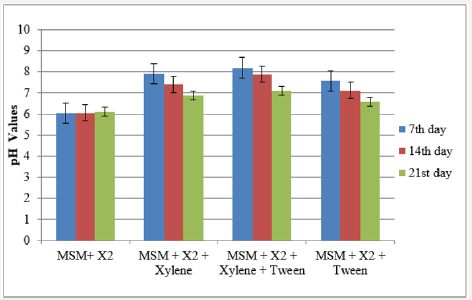
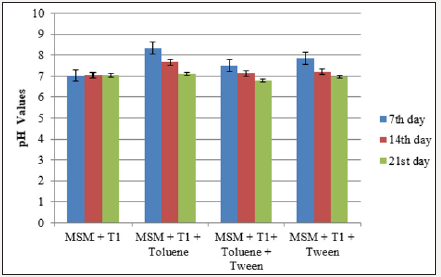
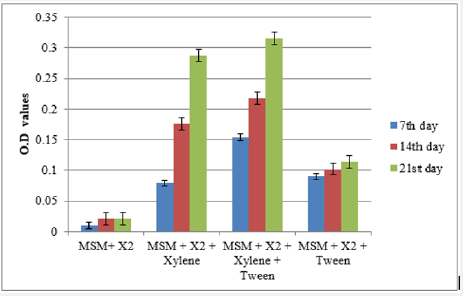
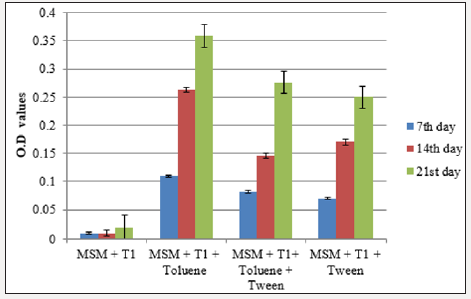

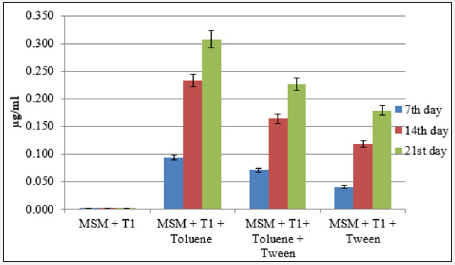
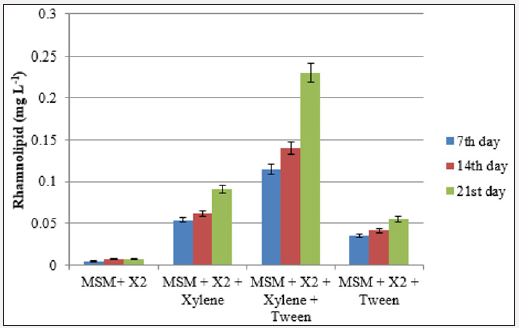
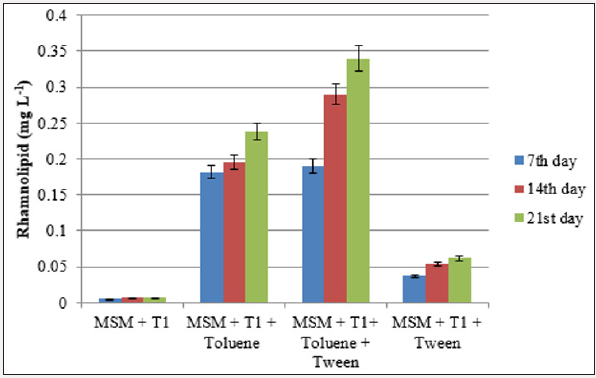
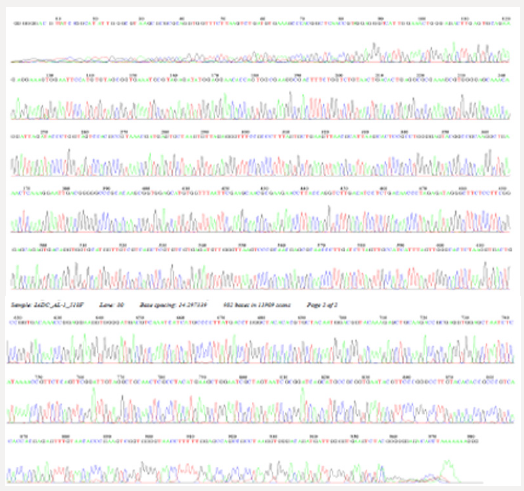
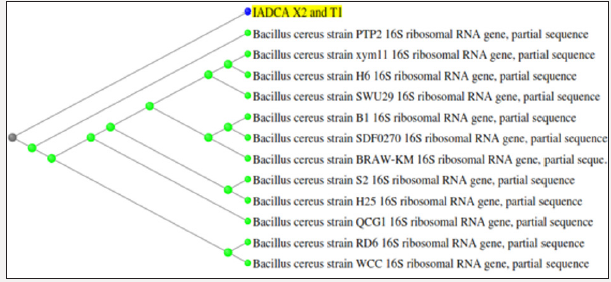
No comments:
Post a Comment
Note: only a member of this blog may post a comment.